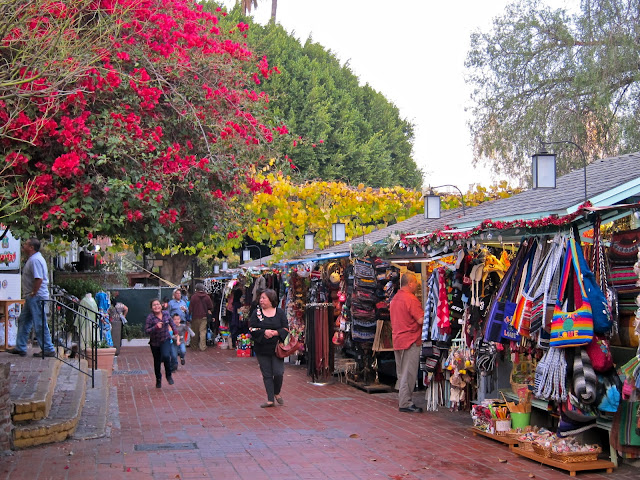On New Year's Eve day, Fred and I set off to explore a new (to us) part of Los Angeles. Based on an article in Sunset Magazine, our goal is the eastern destinations of the Gold Line, an extended set of eight stations that opened late in 2009. This link has a map of the route: http://www.metro.net/around/rail/gold-line/
We begin our trip at Union Station. I love this place and think it's one of the most iconic buildings in L.A. It's grand opening was in 1939 and it still keeps much of its original design, a combination of Moderne and Mission Revival that somehow works. Our plan is to travel east on the Gold Line to its last stop--Atlantic.
 |
| A view of Union Station's clock tower juxtaposed against old and new-- the tip of City Hall (1928) and the U.S. Bank Tower (1989) |
 |
| The classic entrance to Union Station, dating from 1939 |
 |
| Streamline Moderne clock design combined with Mission Revival ceiling |
 |
| Looking down from the entrance; the lower walls are travertine marble and the upper section is an early form of acoustical tile. |
Once there, we walk a few blocks to reach ChimMaya Gallery. This is a very cool gallery with four rooms full of edgy Chicana-Latino artwork and a gift shop filled with jewelry and accessories. It's also beautifully decorated for Christmas! The place is packed with color!! Check out their website: http://chimmayaart.com/gallery/current/
 |
| Met this couple on the train and they gave us a few hints on where to explore. Noticed her dress because I'd never seen that fabric before. |
 |
| The end of the Gold Line, the 'Atlantic' stop. |
 |
| The very enticing gift shop of ChimMaya Gallery leads into four rooms of Latino-Chicano art from a variety of artists, many local. |
|
|
|
|
|
We travel next to Maravilla station, where we're heading for Moles La Tia, a restaurant specializing in entrees with ALL kinds of mole (pronounced mow-lay, NOT the animal) sauces. The essential ingredient of any mole sauce is some kind of pepper, and each sauce can have an additional 20 to 25 more spices and flavorings--very complex. While rather nondescript inside and out, the food was great. We ordered salmon with pistachio mole and a nopales (cactus) salad. We COULD have ordered other entrees like frog legs or quail but were conservative this time.
 |
| Horchata with pink sugar and toasted pumpkin seeds |
|
 |
| A highly-decorated market in the Maravilla area. Maravilla was the original name for East L.A. | | |
Our next stop is Indiana station. We walk to El Mercado, a 3-story marketplace jammed with vendors selling toys, candy, spices, clothing, and lots of food. There's a store selling holistic herbs and, my favorite, a store selling all-things-cowboy, from boots to spurs to saddle blankets. The entire 3rd floor is taken by two large restaurants, each with a full mariachi band that competes with the other. While it's not crowded now, I'm guessing that it'll be full for New Year's Eve celebrations.
 |
| A hint of what's ahead on the third floor - two giant restaurants with dueling mariachi bands singing full out. |
 |
| One of the contending bands singing to a sparsely-populated restaurant crowd that is probably going to grow larger as New Year's Eve day progresses into night. |
 |
| On the second floor of El Mercado you can find many things, including exotic cowboy boots and huge 24" diameter cooking pots. |
 |
| Not only cowboy boots, but hats, blankets, spurs, and saddles are for sale here too. | | | | | | | | |
|
|
|
|
Our final stop is Mariachi Plaza. This place has a fascinating story. Across the street is an old brick residential hotel dating from 1889, now known as the Mariachi Hotel, where many mariachi band members still live. They hang out across the street in the plaza and are available for hire 7 days a week. Before the expansion of the metro Gold Line, the hotel was in danger of being demolished and the plaza run down. Now, there's a bandstand in its center, donated by the state of Jalisco, Mexico, and the area has been designated a historic/cultural landmark by the city of Los Angeles and renovation is in progress.
 |
| Mariachi Plaza, where mariachi bands gather on the weekend, hoping to be hired for fiestas and other special events. |
 |
| A few band members taking it easy, hoping to be hired that night. |
|
We return to Union Station and cross over to Olvera Street. It's the oldest street in Los Angeles and in between the touristy kiosks you can still see historic adobe buildings. It's a nostalgic place for me. I remember going there as a kid and being able to buy 'Mexican jumping beans.' I've heard they're still sold at some places, but not here any more. When we leave, there's music at the entrance to the street and classic cars parked along the roadway next to the plaza. Gearing up to party!
Happy New Year!
Here's hoping that 2012 will bring many new and exciting adventures!
 |
| New Year's festivities have already begun at the entrance to Olvera Street. |
 |
| No lack of merchandise here.... |
 |
| It's 4:30 and the winter daylight is already fading. Olvera Street is our last stop for the day. |



